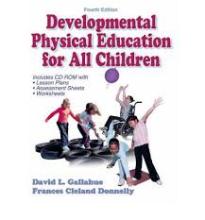
Developmental Physical Education for All Children was written by David L. Gallahue and Frances Cleland Donnelly and was originally published in 1996 with the revised 4th edition published in 2003 by Human Kinetics. The book was written to prepare future teachers to teach physical education using a student-focused, developmentally appropriate approach.
Centering on what is individually appropriate for each student based on their motor, cognitive, and affective development, the book suggests developmental games, dance, and gymnastics to teach fundamental movement skills and concepts to children. The most distinguishing feature of this book is that rather than focusing physical activity to where children should be in age-group appropriateness, it focuses on where children are in terms of their individual appropriateness.
The book is divided into six parts. The first three parts present background information that is essential for successful teaching and the last three parts offer developmental movement experiences for preschool and elementary school children.
Part I – The Learner focuses on the child from a developmental perspective. Chapter 1 gives an overview of the aims and goals of physical education for children along with the seven National Standards for Physical Education. Chapter 2 introduces factors that affect children’s growth patterns and motor skills during early and later childhood. Chapter 3 focuses on movement skill acquisition defining the categories of movement, phases, and stages of motor development. Chapter 4 discusses physical activity and fitness enhancement to incorporate physical activity into children’s lifestyles. Chapter 5 focuses on cognitive learning and perceptual-motor outcomes of physical education. Chapter 6 deals with affective growth, self-concept development, positive socialization, and character education. Chapter 7 introduces the physical needs of children with disabilities and gives a wealth of teaching tips to the future educator in addressing their needs.
Part II – The Teacher provides a realistic view of both the art and the science of teaching. Chapter 8 discusses the responsibilities of the teacher, the characteristics of and stages in becoming an effective teacher, and verbal and nonverbal communication techniques. Chapter 9 gives insight into positive discipline and classroom-management skills with practical suggestions intended to lead children to improved self-control. Chapter 10 introduces various teaching styles that can be implemented to fit the appropriateness of a variety of teaching situations. Chapter 11 delves into lesson planning with the sequencing of the daily lesson, organizing facilities, equipment, instructional aids, and student helpers to implement a movement skill theme. Chapter 12 outlines the essentials for assessing student progress emphasizing movement skill, fitness, and physical activity assessment. Chapter 13 discusses the importance of advocating for the support of both quality and daily physical education programs by fellow teachers, parents, and community leaders.
Part III – The Developmental Program gives instruction on putting the developmentally based physical education program into action. Chapter 14 gives a step-by-step approach to curriculum planning. Chapter 15 focuses on developmental games, dance, and gymnastics as the core content of physical education development with ways to select appropriate activities based on the individual needs of the children. Chapter 16 emphasizes the movement concepts of effort, space, and relationship awareness that are essential for understanding how the body can move. Chapter 17 gives an overview of the necessary conditions of legal liability, the situations that lead to legal action, and the practical ways to minimize legal liability.
Part IV – The Skill Themes contains three chapters that focus on the fundamental movement skills critical to the later learning of complex, or specialized, movement skills. Chapter 18 covers the fundamental stability skills that either gain or maintain balance in static or dynamic movement situations. Chapter 19 focuses on fundamental locomotor skills, such as running, leaping, jumping, and skipping, and non-locomotor skills, such as stretching, bending, and twisting. Chapter 20 discusses the fundamental manipulative skills that are required to throw, catch, kick, trap, strike, volley, bounce, and roll a ball.
Part V – The Content Areas focuses on the three primary content areas of developmental physical education: games, dance, and gymnastics. Chapter 21 presents a four-level developmental progression for including games in the curriculum. Chapter 22 examines the learning outcomes of dance and rhythmic fundamentals, and how to apply movement concepts to creative dance. Chapter 23 examines the role of gymnastics in the developmental physical education program using aspects of the movement framework.
Part VI – The Program Strands deals with the active child, the thinking child, and the feeling child. Chapter 24 provides activities for enhancing children’s aerobic endurance, muscular strength and endurance, and joint flexibility. Chapter 25 deals with children’s cognitive development and with structuring the learning environment to promote critical thinking skills. Chapter 26 addresses the role of physical education teachers in helping children take personal and social responsibility for their actions.1
- 1. Gallahue, David L. and Frances Cleland Donnelly. Developmental Physical Education for All Children. 4th edition. Champaign, IL: Human Kinetics. 2003.

